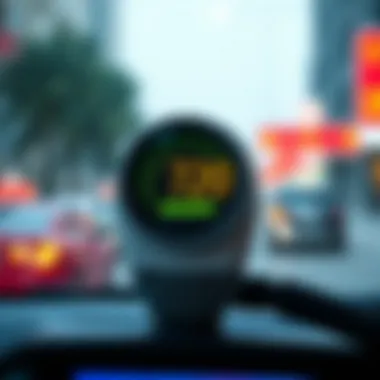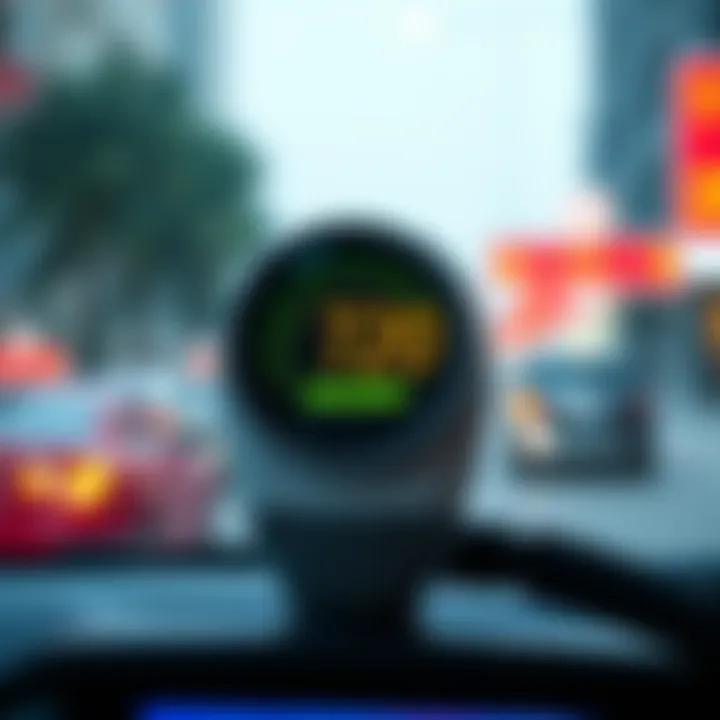A Comprehensive Guide to Taxi Meters in Dubai


Intro
In a city like Dubai, where luxury intertwines with innovation, the taxi meter operates as a crucial cog in the grand machinery of transportation. Understanding how these devices work is not just about knowing the fare; it encompasses grasping demographic factors, technology advancements, and the regulatory frameworks that bind them. This knowledge proves essential for residents and visitors alike, particularly when navigating the bustling streets of the emirates.
Taxi meters in Dubai serve as a bridge between technology and daily life. They not only determine the fare based on distance and time but also reflect broader shifting dynamics within the city’s transportation ecosystem. As the demand for taxis grows, so does the need for transparency and fairness in pricing, positioning the taxi meter as an indispensable tool for both passengers and drivers.
Prelude to Taxi Services in Dubai
In the sprawling expanse of Dubai, where skyscrapers pierced the clouds and luxury seemed to be the norm, the transportation network buzzes with activity. Understanding taxi services in this city is essential for residents and visitors alike, as it opens doors to uncovering the intricate tapestry of urban mobility. Taxis are not just a means of getting from point A to point B; they represent a significant aspect of Dubai's transport ecosystem, offering convenience and accessibility in a city known for its rapid development and vibrant lifestyle.
Overview of Dubai's Transportation Network
Dubai's transportation network is a well-orchestrated ensemble consisting of different modes, including buses, metro, and taxis, each serving specific roles. As one of the fastest-growing cities in the world, it has invested heavily in infrastructure. The Roads and Transport Authority (RTA) oversees all transportation matters, ensuring that everything runs smoothly.
- Metro: The Dubai Metro, stretching across various neighborhoods, offers a modern and efficient means of travel, albeit with limited routes compared to taxis.
- Buses: Complementing the metro, buses connect communities that may not have direct metro access, catering to a broad demographic.
- Taxis: Taxis play a pivotal role, especially in areas not serviced by the metro. They provide an alternative that is often more direct and convenient.
In summary, the transportation network in Dubai reflects its ambition and need for a streamlined connectivity solution. Each transport mode is a vital cog, ensuring that residents and tourists can navigate seamlessly through the bustling city.
The Role of Taxis in Urban Mobility
Taxis in Dubai serve as a reliable lifeline for both residents and tourists. For many, hailing a taxi is not just about avoiding parking fees or traffic jams; it is part of the daily routine and significantly enhances the efficiency of urban commuting. A few important considerations highlight their indispensable role:
- Accessibility: With various taxi services available, such as the RTA taxis and private operators, hailing a cab is usually straightforward, even in busy areas like Downtown Dubai.
- Cost Efficiency: While taxis might deter some with their fares, they often prove to be more economical than owning and maintaining a private vehicle, particularly for those who do not need a car daily.
- Cultural Integration: Taxis in Dubai embody a blend of cultures, with drivers hailing from different backgrounds. This offers passengers not just a ride, but a chance to exchange stories and learn about other experiences.
In closing, the relevance of understanding taxi services cannot be overstated. They provide insight into how Dubai functions and how individuals can navigate the city effectively, transforming mere transit into an enriching experience.
Mechanics of Taxi Meters
The mechanics of taxi meters represent a crucial element in the operation of taxi services in Dubai, contributing significantly to both the passenger experience and the livelihood of taxi drivers. Understanding the intricate details of how these devices function provides insight into the fares incurred during rides, which can help passengers make informed decisions—an important consideration, especially for newcomers to the city. Moreover, a deep dive into these systems can reveal how technology and regulations intertwine to create a reliable transport option.
How Taxi Meters Operate
Taxi meters are not just gadgets that sit on the dashboard; they are sophisticated devices that calculate fares based on various parameters. At their core, taxi meters function by measuring physical travel performed by the taxi, which incorporates both distance and time. The meters adjust fares dynamically, based on pre-set rates established by the local governing body. For example, in Dubai, a standard fare is initiated upon entering the taxi, which is followed by incremental charges based on how far and how long the journey lasts.
Understanding how taxi meters operate involves looking at the delicate balance between technology and regulation. An effective taxi meter uses both distance measurement and time tracking to ensure that passengers pay a fair rate for the service rendered. Without this dual-functionality, discrepancies could arise, leading to disputes between drivers and customers.
Key Components of a Taxi Meter
A taxi meter's components are what make it function effectively. Each part plays a vital role in ensuring accurate fare calculations while maintaining fairness. Let's break down the key aspects:
Distance Measurement
Distance measurement is the first key factor affecting taxi fares. Essentially, it relies on odometry—the process of measuring distance traveled—using various technologies, such as GPS or mechanical devices. The key characteristic of distance measurement is its precision, which ensures that the fare scales accurately with every kilometer traversed.
This method is widely favored because it directly correlates costs with the distance a passenger travels. Moreover, the unique feature of distance measurement in modern taxi meters often includes GPS integration, improving accuracy and allowing for better route optimization. One potential downside, however, could arise from reliance on GPS signals; in some densely built urban areas, there might be occasional inaccuracies due to signal loss.
Time Tracking
The next critical component is time tracking. This aspect is vital, especially in instances where the vehicle is stationary or moving slowly due to traffic conditions. Time tracking adds a fee based on the time spent on a ride, which is especially relevant during peak hours. The main characteristic that makes time tracking effective is its flexibility to adapt fares according to real-time traffic conditions. It presents a balanced approach to fare calculation, where passengers are charged not only for distance but also for time spent in transit.
A key feature of modern time tracking systems integrates seamlessly with GPS-enabled systems. This ensures that passengers are charged fairly, regardless of traffic situations that may arise unexpectedly. A drawback, nonetheless, might be the potential for manipulation if a driver doesn’t utilize the meter correctly, leading to unjust fare increments.
Fare Calculation


Fare calculation is the culmination of the previously mentioned components. This is where distance and time converge to determine the total fare a passenger will pay. The calculation involves established algorithms that take into account multiple factors—base fare, distance, and time rates. A standout trait of this calculation method is how it allows for seamless adjustments in pricing based on varying conditions in the city.
An advantage of a well-implemented fare calculation system is its transparency. Passengers are informed about how their fare is computed, providing a layer of trust in the service. However, one disadvantage lies in the complexity of the fare structures, especially when dealing with peak vs. off-peak rates, which could lead to confusion for passengers unaccustomed to Dubai’s taxi systems.
Understanding the mechanics behind taxi meters is essential for navigating the intricate fabric of the taxi culture in Dubai. By grasping the fundamental aspects of these devices, passengers can better anticipate costs, leading to smoother journeys in this vibrant city.
Determining Fare Rates
Understanding the framework for fare rates is crucial for anyone navigating or investing in Dubai's taxi services. The clarity in fare structures ensures passengers know what they are paying for, and helps drivers manage their earnings effectively. By grasping the mechanics behind fare determination, both locals and tourists can make informed decisions when selecting transportation options.
Standard Fare Structure in Dubai
In Dubai, the taxi fare system operates on a straightforward structure designed for transparency. The initial fare starts as you get into the taxi, followed by a charge based on distance traveled and the time taken. Generally, taxis here utilize a metered system that ensures accuracy. Key components like off-peak discounts and surcharges during peak hours frequently come into play, affecting the final fare.
The starting fare, often referred to as a base fare, is the amount shown on the meter when the ride begins. This is commonly accompanied by per kilometer and time charges that accumulate as your journey progresses. For example, a typical base fare can be around 12 dirhams, with subsequent charges adding a few dirhams for every kilometer and additional time running while in traffic. This structure ensures that the fare reflects the actual travel experience, making for a fair calculation.
Factors Influencing Taxi Fares
While the standard fare structure gives a good baseline, several factors can heavily influence the total fare. Recognizing these elements can empower passengers and help drivers strategize better.
Peak vs. Off-Peak Rates
Peak vs. Off-Peak Rates are significant factors in determining how much a passenger ultimately pays. During peak hours, when demand is high—like during rush hours or large events—fares can increase significantly. This is often due to a surcharge, which can go up to 25% higher than the regular rate.
The unique characteristic of this fare structure is its ability to manage demand. By encouraging rides during off-peak times, taxi services effectively even out traffic and provide better service throughout the day. However, not all passengers are keen on paying more during busy times. Many choose to wait until fares drop, which might lead to longer wait periods.
Location-Based Variations
Location-Based Variations also play an essential role in determining fare rates. Fares can differ remarkably depending on where you are in Dubai. Taxis picking up passengers from prime locations like airports or tourist hotspots may charge higher fares compared to those starting in quieter sectors. This dynamic pricing is intended to manage demand based on proximity to high-traffic locations.
Even though this could be seen as penalizing a passenger for being in a busier area, it caters to the economic realities of operating transport services in high-demand zones.
"Taxi fare structures in Dubai are designed to balance supply and demand, ensuring equitable service for all passengers."
Regulatory Framework Governing Taxi Meters
The regulatory framework governing taxi meters in Dubai plays a crucial role in ensuring a fair, efficient, and transparent taxi service for both residents and visitors. This framework outlines how taxi meters should operate, the standards they must meet, and ensures compliance through regular inspections. Ultimately, it’s designed to enhance user experience and uphold public trust in the transportation system.
Government Oversight and Standards
In Dubai, the operation of taxi meters is under the supervision of the Roads and Transport Authority (RTA), a government entity that establishes the rules and standards that taxi services must adhere to. This oversight is essential for several reasons:
- Consumer Protection: The RTA sets standards that taxi meters must follow to ensure that they operate accurately. This means a passenger is charged based on the actual distance traveled and time spent in the cab, eliminating the risk of overcharging.
- Fair Competition: By regulating taxi meters, the RTA helps maintain a level playing field for taxi operators. All drivers must use meters that comply with the same standards, which can encourage healthy competition based on service quality rather than pricing tricks.
- Technology Integration: The RTA also embraces technology in taxi operations. For example, integrating GPS with taxi meters allows for real-time fare calculation, enhancing accuracy.
The RTA continually reviews and updates these standards to align with international best practices and evolving technology trends. By ensuring that all taxis meet these performance standards, it solidifies the foundation of trust that passengers look for when opting for a taxi service in Dubai.
Compliance and Regular Inspections
Regular inspections are the backbone of the regulatory framework. The RTA conducts assessments on taxi meters to guarantee compliance with established standards. Here are a few key points regarding this aspect:
- Frequency of Checks: Taxi meters are not just set and left. The RTA routinely inspects them—this could be yearly or bi-annually, depending on the service. Such diligence ensures that distortions in fare calculation are promptly identified and rectified.
- Consequences of Non-Compliance: Taxis that fail to comply with regulatory requirements face penalties. This could mean fines, forced suspension of service, or even revocation of their operating licenses. This acts as a significant deterrent against maintaining faulty meters.
- Public Feedback: The RTA encourages passengers to report taxi malfunctions or any irregularities. Such community involvement ensures that taxi services remain accountable.
By maintaining stringent compliance measures and conducting regular inspections, the RTA fosters an environment of safety and reliability in taxi services, enhancing the overall commuting experience in Dubai. Operators are constantly reminded that the responsibility lies not only in providing transport but also in ensuring fairness and equality through their fare systems.


"Trust is the foundation of business, and in taxi services, accurate fare calculation is key to building that trust."
In summary, the regulatory framework surrounding taxi meters in Dubai emphasizes the balance between fair service and technological integration, significantly contributing to a positive experience for passengers. Through ongoing oversight, compliance checks, and the encouragement of public feedback, the RTA plays a pivotal role in shaping the future of taxi services in this bustling city.
Impact of Technology on Taxi Meters
As taxi services continue to evolve in Dubai, the influence of technology on taxi meters cannot be understated. With the increasing push towards modernization, taxi meters are adapting to leverage advanced technology solutions. This section explores the significant role technology plays in the operation and functionality of taxi meters in Dubai, and how these innovations impact both drivers and passengers.
Integration of GPS and Smart Features
The incorporation of GPS technology into taxi meters has revolutionized the way fares are calculated. Not only does this system pinpoint the exact location of the taxi and the passenger, but it also ensures that the most efficient route is taken—meaning less time spent in traffic and potentially lower fares. For taxi drivers, this real-time navigation tool isn’t just handy; it’s essential for maximizing efficiency
By integrating smart features, such as emergency buttons or in-meter communication systems, taxi meters can enhance safety for both drivers and passengers. Features like these can alert authorities in case of any unsafe situation. Overall, the integration of GPS elevates user experience and ensures that both parties can engage in a more informed ride.
Future Trends in Taxi Meter Technology
As we look ahead to the future, several trends are emerging that could further change taxi meters and user experiences in Dubai.
Mobile Applications and Payment Systems
Mobile applications connecting directly with taxi meters are becoming highly popular. Apps like Careem and Uber have made it easy for passengers to book rides seamlessly. These platforms enable cashless transactions, which simplifies fare payments and enhances convenience.
One of the main characteristics of these mobile systems is their ability to offer fare estimates before the ride begins. This feature fosters transparency, allowing users to get a rough idea of costs beforehand.
"Technology has transformed the transport experience, bridging the gap between drivers and riders."
However, the reliance on mobile payment systems isn’t without its downsides. Issues such as connectivity problems can hinder transactions, leading to frustration for users. Still, the overall flexibility and ease in using these apps makes them increasingly common.
Automated Fare Adjustments
Another noteworthy aspect of future taxi meter technology is the system of automated fare adjustments. This innovation is designed to recalibrate fares based on real-time factors such as traffic conditions or special events. The key characteristic of this feature lies in its dynamic nature, allowing for more accurate fare representations that reflect current market conditions.
While this development is advantageous, it also poses challenges. The fluctuating fares can confuse passengers, making them uncertain about costs at the start of their journey. To counter this, clear communication through apps or on-screen displays in the taxis can make a big difference. Thus, while automated fare adjustments offer much-needed flexibility, implementing them with clarity remains critical for user acceptance.
Comparative Analysis of Taxi Meters Worldwide
Understanding taxi meters globally helps us see not just what's happening in Dubai, but also what works elsewhere. Traveling is often a mosaic of experiences influenced by local regulations, technology, and cultural nuances. By examining systems in place across various countries, we can derive some valuable insights into the efficiency and fairness of taxi services. This comparative analysis allows us to identify what elements lead to improving passenger experiences and ensuring fairness in fare calculations.
International perspectives shed light on practices that optimize fare structures, which can be particularly enlightening for travelers and residents alike. Moreover, it emphasizes the importance of aligning local practices with global standards to improve overall service quality.
Global Standards for Taxi Meters
Global standards for taxi meters offer a reference point for regulations and technology. Many countries have implemented guidelines to ensure that taxi meters are accurate, reliable, and secure. These standards often set parameters that cover how meters should calculate fares, how they should be inspected, and what kinds of technologies should be integrated into the systems. For instance, the International Organization for Standardization (ISO) provides standards that many countries adapt for local regulations. In some places, meters must comply with specific legal frameworks, which help protect both passengers and drivers.
Further, these global standards encourage transparency in fare calculation, which is crucial for maintaining trust in taxi services. When customers understand how fares are determined, they are less likely to feel taken for a ride, so to speak. This clarity is often backed by technological innovations that ensure all calculations made by the taxi meter are displayed in real time.
Best Practices from Other Cities
Case Studies from International Metropolises
Cities like London, New York, and Tokyo have long been at the forefront of taxi meter technology. Each city has unique regulations and practices that provide useful lessons for others, including Dubai.
In London, the iconic black cabs employ meters that calculate fares based on both distance and time, accommodating urban traffic variations while ensuring fairness in charges. The drivers undergo rigorous training, which instills a deeper awareness of customer service and regulatory guidelines. This dual focus on technology and human interaction significantly enhances user experience.


New York City implements a comprehensive taxi fare structure, which includes a base fare, surcharges during peak times, and a system for metering trips that may include tolls. This structured approach offers riders predictability while maintaining transparency about potential costs, empowering them to make informed choices about their travel.
Tokyo's taxi system boasts a unique feature known as "shared taxi rides," where passengers can opt to share rides with others traveling in the same direction. This practice not only promotes cost savings but also optimizes operational efficiency. It’s interesting to note how these case studies remove the bells and whistles of taxi services to deliver something truly functional and user-centered.
User Experience and Passenger Rights
The experience of using taxis in Dubai hinges significantly on how well passengers know their rights and what they can expect from the service. In a bustling metropolis like Dubai, where public transport options abound, taxis remain integral to urban commuting. Understanding passenger rights is essential not just for a smoother journey, but it also safeguards riders from potential disputes. When travelers are well-informed, they can better navigate the intricate landscape of taxi services, impacting their overall experience positively.
Understanding Your Rights as a Passenger
When you step into a taxi, you enter a contractual agreement. You have the right to a fair fare based on the meter, courteous treatment, and a safe journey. In Dubai, the regulatory framework supports these rights, ensuring passengers can expect accountability from taxi drivers and companies alike. Here’s a breakdown of passengers’ rights:
- Fair Fare Calculation: The meter should run transparently, calculating the distance and time accurately. If you suspect being charged unfairly, you have every right to question this.
- Safe Environment: Drivers are required to maintain safety standards. If it feels unsafe—whether due to the driver’s behavior or the vehicle condition—you have the right to terminate the ride.
- Service Feedback: Passengers can report issues related to service directly to the taxi company. Whether it’s a complaint about the driver or the vehicle, the system is in place for your voice to be heard.
Common Issues and Resolutions
Navigating taxi services can sometimes lead to bumps in the road. Here, we’ll explore the most common challenges passengers might face and how they might address them, ensuring smoother travels in the future.
Disputes Over Fares
Disputes over fares often arise from misunderstandings about how taxi meters work. Passengers may feel the meter is running too fast or that they were charged for a longer distance than traveled. In such cases, the characteristics of disputes are usually about miscommunication or lack of awareness. Educating oneself about how meters function can reduce these tensions. Here are a few key points to remember:
- Communication: Speak up if you suspect an error. Most taxi drivers appreciate clear communication.
- Documentation: Keep records of your ride (e.g., dates, locations, and fare amounts) to address issues effectively.
- Reporting: If resolution fails, report to customer service of the taxi company. They should guide you through the formal complaints process. In the grander scheme, discussing fare disputes is not just beneficial; it helps build a culture of accountability among taxi services, thus enhancing passenger confidence.
Reporting Malfunctions
Malfunctions in taxi meters can lead to overcharging or lack of proper fare calculation. Timely reports of these issues are crucial not only for your peace of mind but also for the proper functioning of the taxi fleet overall. Here are essential points supporting reporting malfunctions:
- Quick Action: If you notice the meter malfunctioning, alert the driver immediately.
- Customer Support: Providing feedback to the taxi company will ensure they can rectify problems in their vehicles.
- Passenger Safety: Reporting issues helps maintain a safer travel environment. In this context, addressing malfunctions ensures drivers adhere to standards that protect all.
"Knowledge is power—especially when it comes to your ride in the city!"
Delving into the details of your rights as a passenger leads to not only an improved personal journey but contributes overall to establishing a well-functioning and respected transportation system.
Culmination and Recommendations
In synthesizing the wealth of information about taxi meters in Dubai, it becomes clear that understanding these mechanisms is vital for both passengers and drivers alike. The regulatory framework, technological advancements, and fare structures collectively shape the landscape of taxi services, making knowledge on these subjects all the more crucial. Grasping how taxi meters function can significantly influence your experience, ensuring you are neither overspending nor confused when it comes to fare disputes. Equipping oneself with this understanding can lead to more efficient travel that aligns with one's budget and expectations.
Summary of Insights
Throughout this article, several key insights about taxi meters in Dubai have emerged:
- Operational Mechanisms: It’s evident that taxi meters rely heavily on distance and time tracking, ensuring that passengers pay a fair fare based on their journey’s specifics.
- Fare Regulations: The fare structure is standardized but influenced by various factors such as peak times and geographic zones, which can impact pricing.
- Technological Integration: GPS and mobile applications are shaping the future of taxi services, enabling features like automated fare adjustments and real-time tracking, thus improving user experience.
- Passenger Rights: An understanding of passenger rights can empower riders to engage in constructive discussions when disputes arise.
Advice for Navigating Taxis in Dubai
When navigating the taxi services in Dubai, here are a few considerations that can enhance your experience:
Choosing the Right Taxi Service
Selecting a reliable taxi service can greatly affect your travel experience. Factors such as service availability and customer reviews are significant considerations. Many riders favor RTA taxis due to their consistent standards and regulated fares. Additionally, ride-hailing apps provide a modern touch, offering conveniences like cashless payment options and estimated fares. When you opt for a well-regarded taxi service, the assurance of a professional operation can prove invaluable, particularly during peak hours or in busy areas.
Being Informed About Rates
Knowledge of fare structures can save you from unpleasant surprises. Many taxis display fare rates visibly, and apps can provide an estimate before you even step foot inside. Understanding that rates can vary based on the time of day or location will help in planning your outings accordingly. It is essential to ask directly or check app features for precise fare information prior to starting your journey. This practice not only helps in budgeting your trip but also empowers you to address any discrepancies more effectively if they arise.
"Knowledge is power, especially when it comes to navigating urban transport. Being informed prepares you for a smoother ride."
In the context of Dubai’s vibrant transport ecosystem, becoming savvy about taxi meters can significantly enhance your travel experience, ensuring you make informed choices that suit both your needs and your wallet.















